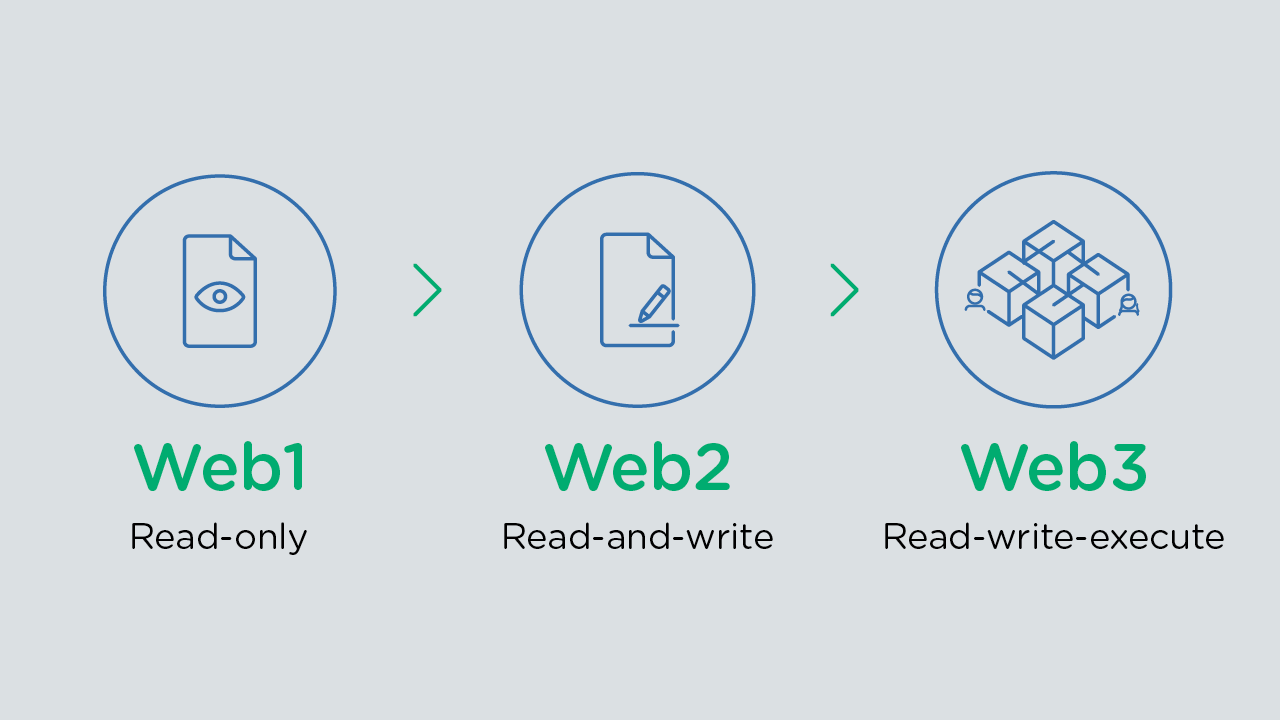Over the next decade, Web3 is expected to significantly transform social and business models. Here’s how your business can prepare to stay ahead of the curve.
As the next generation of the internet begins to emerge, Web3 has gained popularity as the term best used to describe what’s yet to come in the world of online. Beyond its name however, what makes Web3 stand out is the way in which it decentralises data and web user activity.
“Web3 enables peer-to-peer interactions with no reliance on centralised platforms and intermediaries,” explains analyst firm, Gartner1. “Users own their own data, identity, content, and algorithms, and can govern the blockchain protocols they use by owning governance tokens.”
So, how is Web3 different from the internet we know today? To fully understand this, let’s look at how the web has evolved over the last few decades.

The evolution of the web
The first generation of the internet, now characterised as Web1, was mainly designed to help users to find information. In the second, current generation of the web, known as Web2, users create and update information on web pages and participate in content creation. However, user data is often stored and managed on centralised servers owned by big technology companies.
Web3 disrupts the model in Web2 by shifting ownership of user data from centralised platforms to the users themselves. This has the potential to fundamentally transform the way we use the internet. It may also disrupt business models across industries – from finance and banking, and real estate, to media, e-commerce, and logistics.
Gartner2 predicts Web3 technologies are likely to go mainstream in the next decade. By 2024, 25% of enterprises globally will be integrating legacy apps and services with Web3 applications. This means businesses may soon need to look at ways to integrate these applications into their digital foundation. To be able to do this, they need to first understand how Web3 works.
Web3 explained
As Web3 prepares to change the way we do business, it’s important to understand its origins and underlying technology.
In Web3, data and transactions live on a decentralised network of computers using blockchain technology. A blockchain3 is a distributed database, or ledger, shared across a public or private network. “Every transaction on a blockchain is shared among a number of users”, says analyst firm, Gartner. “No central authority, such as a bank, exchange, or intermediary is required to validate the transaction.
Instead, smart contracts4 stored on the blockchain execute digital transactions when certain pre-set conditions are met. These automated transactions can significantly reduce data processing time and cut costs. Moreover, data stored on a blockchain is encrypted, and with each record connected to the previous and subsequent records on the distributed ledger, data cannot be easily altered or manipulated. This can significantly improve trust and transparency in transactions.
So, what does this mean in practice, and what can businesses expect going forward? Consider this scenario: an individual requests a funds transfer. The request is read by a smart contract. It follows a series of protocols and releases the funds to the receiving party. The entire transaction is automatically executed without involving a bank or a central authority.

How Web3 is disrupting industries
Blockchain-based Web3 technologies are already disrupting many industries and may disrupt more in the near future.
In finance, Decentralised Finance (‘DeFi’)5 could replace the decades-old, siloed systems that still exist in many parts of the industry. DeFi promises to provide a single source of truth that allows multi-party transactions to be processed quickly and securely. Records management driven by smart contracts is enabling financial organisations to reduce reliance on paper records and processes. This can potentially reduce fraud by dynamically authenticating records submitted by applicants, for example.
Meanwhile, retailers are using decentralised environments to help ensure the authenticity of products and to manage logistics. Many artists today are directly selling their digital media to their fans via non-fungible tokens (NFTs)6 on peer-to-peer networks.
In Australia, a few big implementations of Web3 technologies are already underway. For example, a Decentralised Autonomous Organisation (DAO), a blockchain-based governance model, could soon help revitalise parts of Melbourne CBD7 by involving stakeholders in the Docklands area to share data.
Preparing for the decentralised future
Enterprises that start investing in Web3 today could potentially unlock significant business opportunities and gain a competitive advantage as Web3 matures and standards develop.
The decentralised nature of Web3 transactions means businesses may need to cope with a large size and volume of data being exchanged. They may also need to consider investing in a digital foundation that can power such transactions.

nbn is laying the digital backbone to help lift the digital capabilities of Australian businesses. Plans from service providers powered by business nbn include services and speeds that can support multi-party applications on a distributed network. The business nbn® fibre initiative also means more locations around Australia have access to a business-grade wholesale Enterprise Ethernet service.+
Powered by a reliable, business-grade network, enterprises can adopt Web3 technologies and be future-ready.
Find support for your business
Sources
- Gartner: What is Web3?
- Gartner Hype Cycle for Blockchain and Web3, 2022
- Splunk: What is blockchain?
- Investopedia: What are smart contracts?
- Investopedia: What is Decentralised Finance (DeFi)?
- Investopedia: Non-Fungible Token (NFT): What It Means and How It Works
- RMIT: Decentralised Autonomous Organisations (DAOs) could revitalise precincts in the Melbourne CBD
